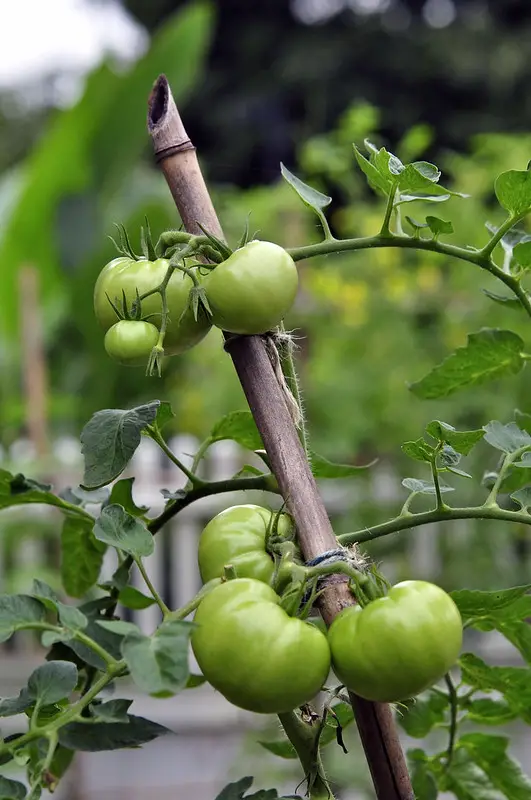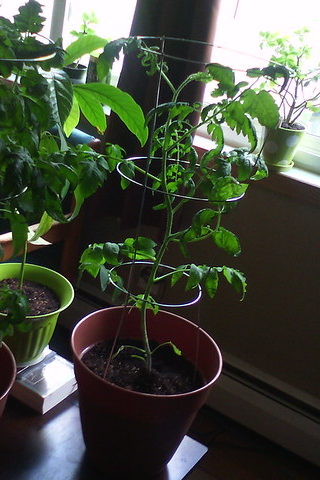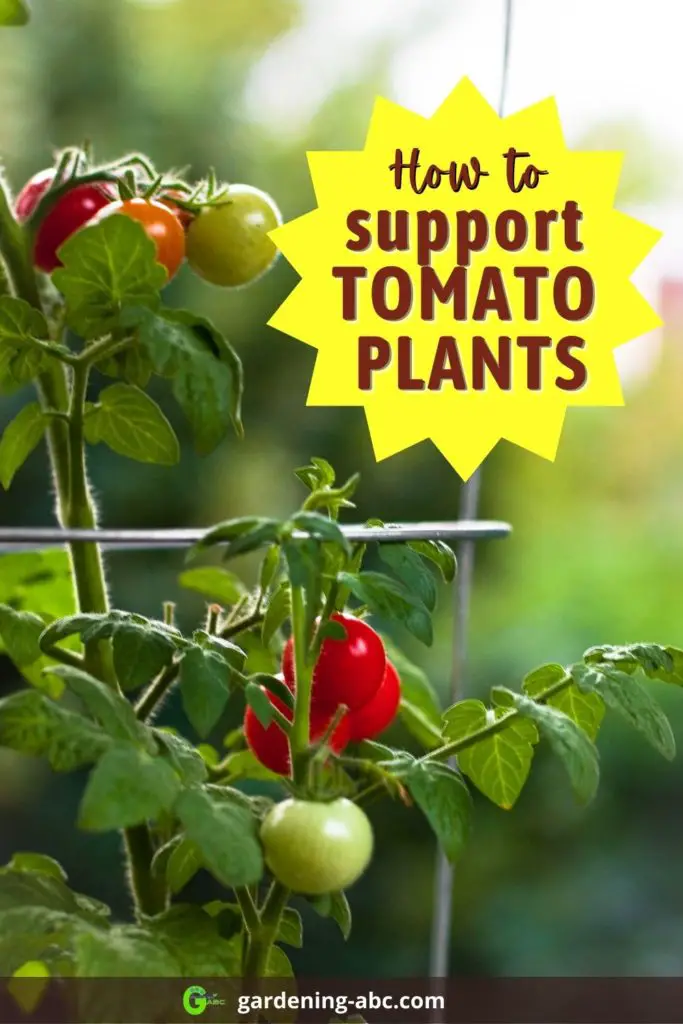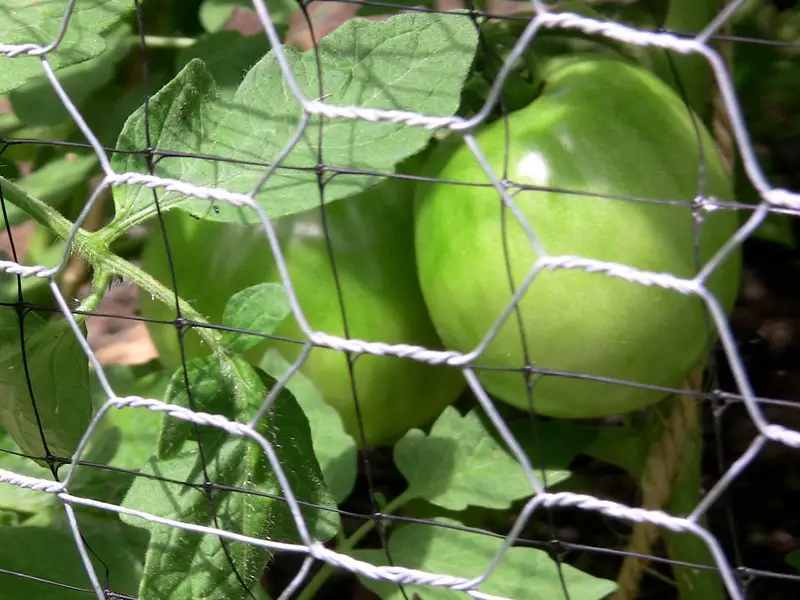We use affiliate links to run our site. When you buy through links on our site, we may earn an affiliate commission, without any added cost to you. Learn more
Tomatoes are a versatile crop that can be grown in a variety of climates and soils. However, they do need some support to keep them healthy and productive. This can be in the form of cages, trellises, or staking.
In this post, we will discuss some of the most common ways to support your tomato plants.
Do Tomato Plants Need Support:
Tomatoes need support to grow. Other than the food, light, water, and pruning tomatoes also require support to effectively grow and bear fruits.
Though people might argue that bush varieties are capable enough to grow without support, the reality is when they start fruiting the plant can get weighed down by heavy fruits.
Plants That Need Support:
Some plants need support while they grow, while others don’t. In most cases, seed packs will tell you which plants will vine out and will need support, but sometimes, you may also have to figure it out yourself.
Following is a list of some of the common plants that need support to grow:
- Tomatoes
- Peas
- Cucumber
- Beans
- Squash
- Grapes
if you don’t give the necessary support to the above plants they won’t be able to develop properly and end up deformed. As they keep lying on the ground they become more susceptible to pests and diseases.
By supporting your plants you also save space as you help them go vertically.
Why Support Tomatoes:
Here are the main reasons why you should support your tomato plants:
- Supporting helps reduce tomato diseases
- Support structures make it easier to harvest tomatoes.
- Your tomatoes will be clean and free from dirt.
- You can monitor your plants easily and check for any pest infestation at a very early stage.
Supporting Tomato Plants:
There are mainly two types of tomato plants, Determinate and Indeterminate. Though both of them need support to thrive, the types of support are different.
As determinate varieties mature fast they generally stop growing once they reach a height of 3 to 4 feet. They also fruit all at once. So the support needs to bear the large weight of multiple ripening fruits.
Due to this a tomato cage is ideal for supporting determinate tomato plants. You can buy tomato cages locally or through online stores.
Tomato cages can support tomatoes in containers as well as outdoors.
Indeterminate varieties on the other hand produce fruits throughout the whole season and continue to grow and branch out. Mature plants can reach heights of more than 10 feet.
Due to this reason, you can support the plants by applying a trellis. Though you can also use tomato cages, they have to be quite large compared to the determinate variety cages.
Different Support Options For Tomatoes:

Although you can give support to your tomato plants in many ways, here are some of the most common support structures:
- Stake
- Trellis
- Cage
- Fence
Tomato Stakes:
Staking is the most common form of support for tomatoes, and it is relatively simple to do. Just drive a stake into the ground next to the plant and tie the plant to the stake with some soft twine or strips of cloth.
Tomato stakes can be a great way to help keep your tomatoes in place during the growing process. They can also be a helpful way to mark your plants so that you know where they are in relation to each other.
Stakes are available in a variety of sizes and materials, You can use wooden, bamboo, or any type of stake to support your plant. Ideally, it should be more than 4 feet in height. Stakes can also be customized to fit your specific needs.
Once the tomato plant starts growing keep tieing the plant with the stake using plant ties. First, tie around the stake and then lightly secure it to the main stem. Be sure to tie the plant loosely so that it can still move a little bit in the wind. This will help to prevent the plant from being damaged by strong winds.
Some tips for using tomato stakes:
- Select a stake that is the right size for the tomato you are using it on.
- Thread the stake through the main stem of the tomato so that it is secure.
Staking your tomatoes might take a lot of effort but this is one of the cheapest ways to support your plant.
The Florida Weave method:
This is a system of training and supporting tomato plants that allows the plants to grow vertically. The Florida Weave method uses a series of horizontal wires that are attached to posts to create a support system for the tomato plants. The wires are spaced about 18 inches apart, and the tomato plants are trained to grow along the wires.
The Florida Weave Method is particularly useful for growing indeterminate tomatoes. As the plants grow, they are woven in and out of the wire, creating a horizontal “weave” pattern.
This method has several benefits, including improved air circulation and sun exposure, reduced disease pressure, and easier harvesting.
Tomato Cages:

Tomato cages provide the best support for determinate tomato varieties. They allow the tomato plant to grow upwards, and during fruiting, and also give support to the heavy branches loaded with ripening tomatoes.
The cage prevents the tomato plant from toppling or breaking completely due to the heavyweight.
If you are using cylindrical or square wire cages You don’t need to tie the stems to keep the plant upright.
The best time to put the cage is when the plant is young. If you place the cage later in the soil it can damage the roots or vines. Setting the cage early on the other hand allows the tomato roots to grow without any disturbances.
Cages are also a good option for supporting tomatoes. They are easy to find at garden stores, and they can be placed around the plant before it starts to grow. Just make sure that the cage is tall enough to support the plant as it grows taller.
Tomato Trellis:
To train your tomatoes to achieve maximum yield you can use trellis support. A trellis can be made out of wood, metal, or plastic, and it can be either freestanding or attached to a wall or fence.
In a trellis system, your tomato plants are supported both vertically as well as horizontally. You can easily make your trellis support system all you need is some stakes, some twines, and some patience.
Trellises provide more support than cages. It may seem a bit costly in terms of money and time but it usually pays off at the time of tomato harvesting.
You can also make a DIY tomato trellis all by yourself.
Using Fence Structure:
This is using your current garden fence to grow tomatoes. Garden fencing can be done in various ways, and you can use the structure to give support to your tomato plants. To use this idea, grow tomato plants near the garden fence.
If you don’t have any fences, you can buy wire fencing like this.
Like the post? Don’t forget to PIN IT

Amazon and the Amazon logo are trademarks of Amazon.com, Inc, or its affiliates.

Hi there! My name is Prasenjit and I’m an avid gardener and someone who has grown a passion for growing plants. From my hands-on experience, I have learned what works and what doesn’t. Here I share everything I have learned.
